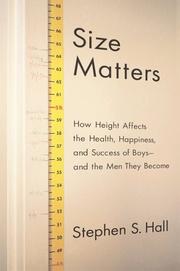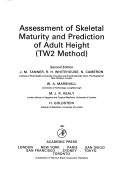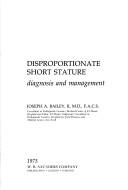| Listing 1 - 10 of 14 | << page >> |
Sort by
|
Book
ISBN: 0295801646 9780295801643 0295990872 9780295990873 0295990880 9780295990880 Year: 2011 Publisher: Seattle University of Washington Press
Abstract | Keywords | Export | Availability | Bookmark
 Loading...
Loading...Choose an application
- Reference Manager
- EndNote
- RefWorks (Direct export to RefWorks)
Short men --- Stature, Short --- Masculinity in literature. --- English literature --- Men --- Short people --- Short stature --- Small stature --- Stature, Small --- Stature --- Masculinity (Psychology) in literature --- Social aspects --- History and criticism. --- Geschichte 1700-1800.

ISBN: 9780618470402 0618470409 Year: 2006 Publisher: Boston (Mass.) : Houghton Mifflin,
Abstract | Keywords | Export | Availability | Bookmark
 Loading...
Loading...Choose an application
- Reference Manager
- EndNote
- RefWorks (Direct export to RefWorks)
With a bracing mix of fresh research, incisive reportage, and personal candor, Size Matters uncovers the causes and effects of societyʼs bias against shortness and reveals how short people can and do thrive in spite of this insidious bigotry. Drawing on his own childhood experience (he was shorter than 99 percent of boys his age) and extensive investigation and interviews, Stephen Hall explores the fraught phenomenon of bullying and charts its lifelong consequences. He seeks out the factors determining that one personʼs small stature will lead to low status while another short person develops resilience that will enrich his later life. Hall pinpoints the forces that create and cash in on our anxieties about size, from superhero action figures to drug companies that sell a hormone that increases childrenʼs height (at a cost of up to 40,000 dollars a year). He visits families agonizing over whether to make that huge investment. He hangs out with teenagers who will do whatever it takes to grow taller, and he uncovers the sources of the intense pressure they feel. He even tracks down the kid he once bullied in grammar school, who was, of course, the only one shorter than he. Along the way, Hall builds a persuasive case against societal attitudes that make size (or any difference) matter and argues forcefully for the advantages of being short. Size Matters will raise the consciousness-and the spirits-of any short male and anyone who cares about him.
Body image in men. --- Body image in men. --- Body image. --- Body image. --- Human growth. --- Human growth. --- Junger Mann. --- Kleinwuchs. --- Knabe. --- Körperbild. --- Körpergrösse --- Körpergrösse --- Körpergrösse. --- Mann --- Mann. --- Minderwuchs. --- Psychische Entwicklung --- Psychische Gesundheit. --- Psychische gesundheit. --- Psychologie. --- Puberty. --- Puberty. --- Sozialpsychologie. --- Stature, Short --- Stature, Short --- Stature, Short --- Stature, Short --- Mann. --- Psychische Entwicklung. --- Körpergrösse. --- Körpergrösse. --- Psychological aspects. --- Psychological aspects. --- Social aspects. --- Social aspects.
Book
Year: 2003 Publisher: Amsterdam : Stichting Nederlands Museum voor Anthropologie en Praehistorie,
Abstract | Keywords | Export | Availability | Bookmark
 Loading...
Loading...Choose an application
- Reference Manager
- EndNote
- RefWorks (Direct export to RefWorks)
Archeologische vondsten. --- Human remains (Archaeology) --- Human remains (Archaeology). --- Medical archaeology --- Medical archaeology. --- Medical economics --- Medical economics. --- Menselijke resten. --- Nutrition and dental health --- Nutrition and dental health. --- Stature --- Stature. --- Voedingsgewoonten. --- Benelux countries.

ISBN: 0126833508 Year: 1975 Publisher: London Academic Press
Abstract | Keywords | Export | Availability | Bookmark
 Loading...
Loading...Choose an application
- Reference Manager
- EndNote
- RefWorks (Direct export to RefWorks)
Anthropometry --- Children --- Skeletal maturity --- Stature. --- Statistical methods --- Age determination --- Growth --- Testing --- Skeletal maturity. --- Statistical methods. --- Age determination. --- Testing.
Book
ISBN: 9783034305860 3034305869 Year: 2011 Volume: 13 Publisher: Bern : Peter Lang,
Abstract | Keywords | Export | Availability | Bookmark
 Loading...
Loading...Choose an application
- Reference Manager
- EndNote
- RefWorks (Direct export to RefWorks)
Stature --- Nutrition --- Diet --- Population --- Anthropometry --- History. --- Economic aspects --- History --- Economic development --- Anthropométrie --- Développement économique --- Health aspects --- Histoire --- Aspect sanitaire --- Anthropométrie --- Health aspects.

ISBN: 0721614701 Year: 1973 Publisher: Philadelphia (Pa.): Saunders
Abstract | Keywords | Export | Availability | Bookmark
 Loading...
Loading...Choose an application
- Reference Manager
- EndNote
- RefWorks (Direct export to RefWorks)
Body Height. --- Dwarfism. --- Growth Disorders --- Nanism --- Body Heights --- Height, Body --- Heights, Body --- diagnosis. --- therapy. --- Dwarfism --- Body Height --- Growth retardation --- Growth disorders --- Stature, Short --- diagnosis --- therapy
Book
ISBN: 2735118479 2735113620 2735111865 Year: 2008 Publisher: Éditions de la Maison des sciences de l’homme
Abstract | Keywords | Export | Availability | Bookmark
 Loading...
Loading...Choose an application
- Reference Manager
- EndNote
- RefWorks (Direct export to RefWorks)
Imaginons une société dans laquelle les hommes seraient en majorité plus petits que les femmes (ou les femmes plus grandes que les hommes, selon le point de vue). Impossible, pensons-nous ? Parce que tout ce que fait la Nature est « bien fait »? Et si, en la matière, la Nature était loin de produire des adaptations positives ? Et si, en plus, cette différenciation morphologique n'était pas l'œuvre de la Nature ? Si elle était plutôt l'indice de sélections non naturelles constituées par une entreprise de catégorisation sociale millénaire : le genre ? L'auteur discute dans cet ouvrage des explications évolutives du dimorphisme sexuel de taille corporelle entre mâles et femelles dans le monde vivant. Elle attire l'attention sur l'absence d'un modèle robuste qui rende compte de l'écart sexué de la stature dans l'espèce humaine; en confrontant des données et des modèles disponibles dans des champs disciplinaires éloignés, elle fait peu à peu émerger une hypothèse inédite. Cette recherche illustre le besoin de questionnements transdisciplinaires qui se montrent seuls ici capables de renouveler les termes d'une investigation remarquablement gelée depuis le xixe siècle.
Stature --- Sex differentiation. --- Human evolution. --- Sex differences. --- Differentiation, Sex --- Sex --- Sexual differentiation --- Body height --- Body stature --- Height, Body --- Cause and determination --- Evolution (Biology) --- Physical anthropology --- Evolutionary psychology --- Human beings --- Embryology --- Sex chromosomes --- Anthropometry --- Body size --- Posture --- Origin --- Social Anthropology --- Sexual Evolution and Size --- Gender Studies
Book
ISBN: 0702048690 0702031097 9780702031090 9780702048692 Year: 2010 Publisher: Edinburgh ; New York : Churchill Livingstone,
Abstract | Keywords | Export | Availability | Bookmark
 Loading...
Loading...Choose an application
- Reference Manager
- EndNote
- RefWorks (Direct export to RefWorks)
Developing a coherent model of human movement is a core value to many manual therapists. Beach proposes the Contractile Field (CF) model, which decodes the traditional Chinese meridian map, promotes a new approach to exercise, and is of great value in understanding and treating musculoskeletal distress.
Manipulation (Therapeutics) --- Acupuncture points. --- Posture. --- Human locomotion. --- Human mechanics --- Kinesiology --- Locomotion --- Body position --- Erect position of human beings --- Position, Body --- Human beings --- Stature --- Acupoints --- Acupressure points --- Acupuncture meridian points --- Meridian acupuncture points --- Points, Acupuncture --- Anatomy, Surgical and topographical --- Moxa --- Manipulative therapy --- Manual medicine --- Orthopedic manipulation --- Orthopedics --- Physical therapy --- Attitude and movement
Book
ISBN: 9780691124575 0691124574 Year: 2006
Abstract | Keywords | Export | Availability | Bookmark
 Loading...
Loading...Choose an application
- Reference Manager
- EndNote
- RefWorks (Direct export to RefWorks)
Dinners and dining --- Posture --- Social classes --- Repas --- Classes sociales --- Rome --- Civilization. --- Social life and customs. --- Civilisation --- Moeurs et coutumes --- History. --- Rome (Italy) --- Class distinction --- Classes, Social --- Rank --- Caste --- Estates (Social orders) --- Social status --- Class consciousness --- Classism --- Social stratification --- Body position --- Erect position of human beings --- Position, Body --- Human beings --- Stature --- Banquets --- Dining --- Eating --- Meals --- Caterers and catering --- Entertaining --- Etiquette --- Cooking --- Gastronomy --- Menus --- Table --- History --- Attitude and movement
Book
ISBN: 0890042594 Year: 1979 Publisher: New York (N.Y.): Raven Press
Abstract | Keywords | Export | Availability | Bookmark
 Loading...
Loading...Choose an application
- Reference Manager
- EndNote
- RefWorks (Direct export to RefWorks)
Animal psychology and neurophysiology --- Physiology: movement organs, voice and skin --- Physiology of nerves and sense organs --- Posture --- Sensorimotor integration --- Human beings --- Congresses --- Attitude and movement --- 612.8 --- -Sensorimotor integration --- -Human beings --- -#MILO:GIFT OSTYN/93 --- Homo sapiens --- Human race --- Humanity (Human beings) --- Humankind --- Humans --- Man --- Mankind --- People --- Hominids --- Persons --- Integration, Sensorimotor --- Intersensory integration --- Perceptual-motor integration --- Sensimotor integration --- Sensory integration --- Sensory-motor integration --- Perceptual-motor processes --- Sensory integration dysfunction --- Body position --- Erect position of human beings --- Position, Body --- Stature --- Zenuwstelsel. Zintuigen. Motorische neurowetenschappen --- -Congresses --- Movement --- Congresses. --- #MILO:GIFT OSTYN/93 --- Attitude and movement&delete&
| Listing 1 - 10 of 14 | << page >> |
Sort by
|

 Search
Search Feedback
Feedback About UniCat
About UniCat  Help
Help News
News